

EVERYDAY CHEESEMAKING
How to Succeed Making Dairy and Nut Cheese at Home
K. Ruby Blume
First Printing, July 1, 2014
All text is K. Ruby Blume, 2014
This edition is by Microcosm Publishing, 2014
All photos by K. Ruby Blume except where noted.
Published by:
Microcosm Publishing
2752 N Williams Ave
Portland, OR 97227
In the DIY series
For a catalog, write or visit
MicrocosmPublishing.com
ISBN 978-1-62106-592-0
This is Microcosm #150
Distributed in the United States and Canada by Independent Publishers Group and in Europe by Turnaround.
Edited by Lauren Hage
Designed by Joe Biel
Fonts by Ian Lynam
Cover by Meggyn Pomerleau
This book was printed on post-consumer paper by union workers in the United States.

 CONTENTS
CONTENTS
 INTRODUCTION
INTRODUCTION 
Everyday Cheese for Everyday People
Artisan cheesemaking requires patience, technique, and either computer-controlled environments or millennia of practice handed down from generation to generation. For the rest of us holding down a job, paying the rent, and/or raising a couple kids, we probably dont have the bandwidth or the time to succeed. Many cheese projects take upwards of two days and razor sharp precision to get anything like what we expect from the store. This doesnt mean we cant make some cheese; only that we need to have realistic expectations about what is possible in a home environment for a normal person with a busy life. Everyday cheeses are those that anyone can succeed at while holding a baby in one arm, stirring milk with the other, organizing a party, and texting with their feet. These cheeses do not require absolute sterility, exactitude of timing or temperature, or investing in fancy equipment. They are made quickly and easily in the times of abundance to preserve valuable proteins for leaner times. Everyday cheeses are reliable and resemble something good youd like to put in your mouth, even when your production process is somewhat loose and free.
Why This Book?
When I decided to make cheese I was already well into a life of do-it-yourself homesteading and crafty know-how. I had been growing my own food for twenty years, and canning, brewing, and fermenting for ten. I figured cheesemaking would be pretty much like any other heirloom skill and it would be no problem to get up to speed. I purchased a home cheesemaking book, tried to follow the recipes, and failed again and again to create a product equal in quality and taste to what I could buy in the store. Isnt homemade supposed to be better? Many of the key techniques were not well-described in the book; nor did it contain encouraging advice for beginners, pitfalls to watch out for, or relevant troubleshooting tips.
Somewhat discouraged, I continued my research, stumbling upon a funky little website that offered a step-by-step home cheesemaking course with lots of DIY workarounds. Hosted by a retired biology professor, Fankhausers Cheese Page states the obvious: start with the easy stuff and build your skills. I began perusing books and websites for cheese recipes that one could, as a beginner, follow and succeed with. Around the same time, I founded a small school of urban sustainability and heirloom skills and began teaching others to make cheese.
At that time, home cheesemaking had not yet caught on, but the class sold out as fast as I could offer it. At every class, I spoke with people who had had the same experience as myself. They read a book, tried to follow a recipe, and became discouraged. So the reason for this book is simple: I want you to succeed.
I offer my experience and research in the hopes of making home cheesemaking a doable, pleasurable, and successful enterprise on your first attempt. You will learn about cheesemaking equipment, ingredients, and processes from a practical, non-artisan perspective as well as gaining an understanding of the many variables that can affect the outcome of your finished product. Ill give you dozens of tried and true recipes, troubleshooting tips, ways to fix a recipe gone wrong, and the opportunity to make and eat homemade products that taste better than you can buy at the store.

Dairy and Vegan in the Same Book?
Along with increasing awareness about our food and how it is sourced comes a diversity of choices people make about their diet. We are seeing more and more mixed households. Vegetarians who raise free-range birds to feed their kids, vegan dads with omnivore moms, and everything else in between. As a gluten-free omnivore who has dabbled in the Paleolithic diet, I appreciate the option of a tasty, cultured, high-protein alternative to dairy. I also love to be able to share something homemade and delectable with my vegan friends while we hash out the ethics and reasons behind our choices. Whether or not we agree in the end, most agree that some kind of cheese is a good thing. Therefore my intent is to go boldly forth and offer something for everyone in the household.
How to Use This Book
If you are going to work mainly with dairy, I encourage you to start at the beginning of the dairy section and work your way through. Once you have read about equipment and ingredients, the projects are organized from easy to more difficult and the skills build upon each other. Try each recipe at least twice before moving on. While you are working on that, read about the hard cheeses process. This section details many of the cheesemaking skills and processes you will need for later recipes and it will further your understanding of the variables that come into play in dairy cheesemaking. All the recipes may be made with cow milk, goat milk, or a blend of the two.
If you will be working with nuts and seeds, the projects are all similarly difficult. Read about equipment and ingredients, and then start with the recipes that interest you.
If you master all of the recipes in this book, you will have quite a repertoire of cheeses. You may stop there or purchase an artisan cheese book and try your hand at some aged cheeses. Consider picking one recipe and making it at least ten times, should you do so. It is pretty much guaranteed that it will not come out the same way twice. Through repetition and careful record-keeping, you will slowly understand the variables and how they affect your end product.
All temperatures are in Fahrenheit. T=tablespoon, t=teaspoon, c=cup
 ETHICAL CHEESE
ETHICAL CHEESE
I spent the 1980s and 1990s in the street, using giant puppets, stiltwalking, and other imagery to protest nuclear energy, the war in Iraq, the destruction of the redwood forest, racism, sexism, homophobia, and world economic injustice. After fifteen years and thousands of hours in the street, I was burnt out and disillusioned. Our efforts hardly seemed to make a dent in the injustice and inequity in the world. I took a break and spent a number of years studying permaculture and botany; learning to grow food and tend bees. I also spent time thinking and talking about what I might do to facilitate a change that I could more sustainably offer. The term localism was newly coined and urban farming was still unheard of. But there was excitement in the air, and my friends were asking me to teach them what I had been learning.
Next page
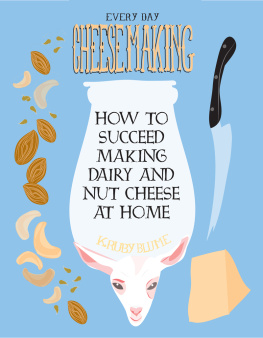

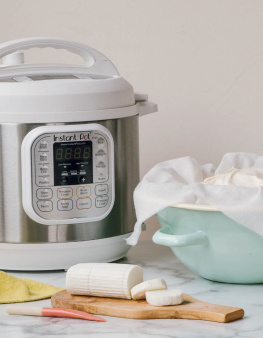
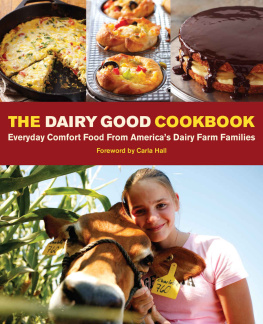

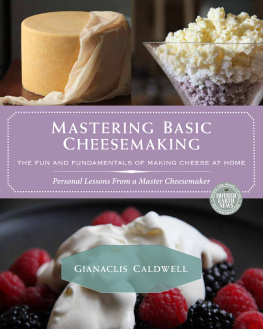
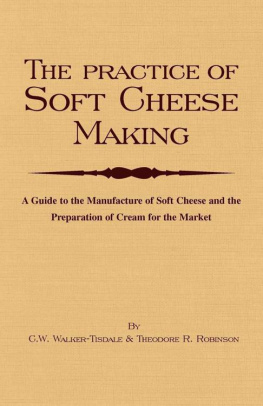



 CONTENTS
CONTENTS
 INTRODUCTION
INTRODUCTION 
